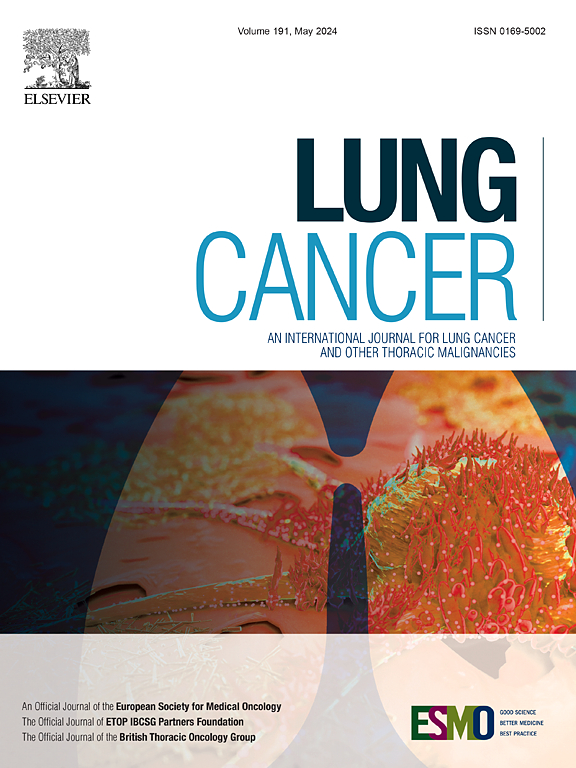用于预测可切除ALK+非小细胞肺癌复发和相关费用的阿勒替尼治疗影响模型
IF 4.4
2区 医学
Q1 ONCOLOGY
引用次数: 0
摘要
基于III期ALINA试验,alectinib获得美国批准,成为首个间变性淋巴瘤激酶(ALK)酪氨酸激酶抑制剂,用于辅助治疗可切除的ALK +非小细胞肺癌(NSCLC)。我们使用治疗影响模型来评估与化疗相比,阿勒替尼相关的人群水平临床获益和成本节约。材料和方法:在2024年至2028年期间,对美国IB-IIIA期ALK+ NSCLC患者的5个年度队列进行阿勒替尼与化疗的治疗相关成本估算;每个队列都被跟踪了10年。数据来源包括ALINA。模拟了两种治疗方案,所有患者接受(1)阿勒替尼和(2)化疗的辅助治疗。对于每种情况,该模型模拟了接受辅助治疗并经历转移性或非转移性复发或死亡的患者数量以及治疗相关和下游复发成本。敏感性分析的关键假设各不相同。采用概率敏感性分析对关节参数不确定性的影响进行了评价。结果在2024-2028年,估计有3130例可切除的ALK+ NSCLC患者将有资格接受阿勒替尼的辅助治疗。与化疗相比,alectinib估计可预防1,531例复发和死亡,其中包括1,059例转移性NSCLC复发,从而避免了13.1亿美元的复发和死亡相关费用。考虑到前期辅助治疗费用,与化疗相比,阿勒替尼估计节省了3.47亿美元。结论:在美国,阿勒替尼辅助治疗改善了人群水平的临床结果,并有望节省成本。当所有患者都接受ALK生物标志物检测时,预测的alectinib益处最大化。本文章由计算机程序翻译,如有差异,请以英文原文为准。
A treatment-impact model of alectinib for the prediction of recurrence and associated costs in treating resectable ALK+ non-small cell lung cancer
Objectives
Based on the Phase III ALINA trial, alectinib gained US approval as the first anaplastic lymphoma kinase (ALK) tyrosine kinase inhibitor for adjuvant treatment of resectable ALK + non-small cell lung cancer (NSCLC). We used a treatment impact model to estimate associated population-level clinical benefits and cost savings of alectinib vs chemotherapy.
Materials and Methods
Treatment-associated costs for alectinib vs chemotherapy were estimated for five annual cohorts of US patients with stage IB-IIIA ALK+ NSCLC between 2024 and 2028; each cohort was followed for 10 years. Data sources included ALINA. Two treatment scenarios were modelled, with all patients receiving adjuvant treatment with (1) alectinib and (2) chemotherapy. For each scenario, the model simulated the number of patients who received adjuvant treatment and experienced metastatic or non-metastatic recurrence or death and treatment-associated and downstream recurrence costs. Key assumptions were varied in sensitivity analyses. The impact of joint parameter uncertainty was evaluated using probabilistic sensitivity analysis.
Results
In 2024–2028, an estimated 3,130 patients with resectable ALK+ NSCLC would be eligible for adjuvant alectinib treatment. Relative to chemotherapy, alectinib was estimated to prevent 1,531 recurrences and deaths, including 1,059 recurrences to metastatic NSCLC, thus avoiding of $1.31 billion (USD) in costs associated with recurrences and death. Considering upfront adjuvant treatment costs, alectinib was estimated to save $347 million vs chemotherapy.
Conclusions
Adjuvant alectinib treatment improved population-level clinical outcomes and was predicted to generate cost savings in the US. Predicted alectinib benefits were maximized when all indicated patients were tested for the ALK biomarker.
求助全文
通过发布文献求助,成功后即可免费获取论文全文。
去求助
来源期刊

Lung Cancer
医学-呼吸系统
CiteScore
9.40
自引率
3.80%
发文量
407
审稿时长
25 days
期刊介绍:
Lung Cancer is an international publication covering the clinical, translational and basic science of malignancies of the lung and chest region.Original research articles, early reports, review articles, editorials and correspondence covering the prevention, epidemiology and etiology, basic biology, pathology, clinical assessment, surgery, chemotherapy, radiotherapy, combined treatment modalities, other treatment modalities and outcomes of lung cancer are welcome.
 求助内容:
求助内容: 应助结果提醒方式:
应助结果提醒方式:


